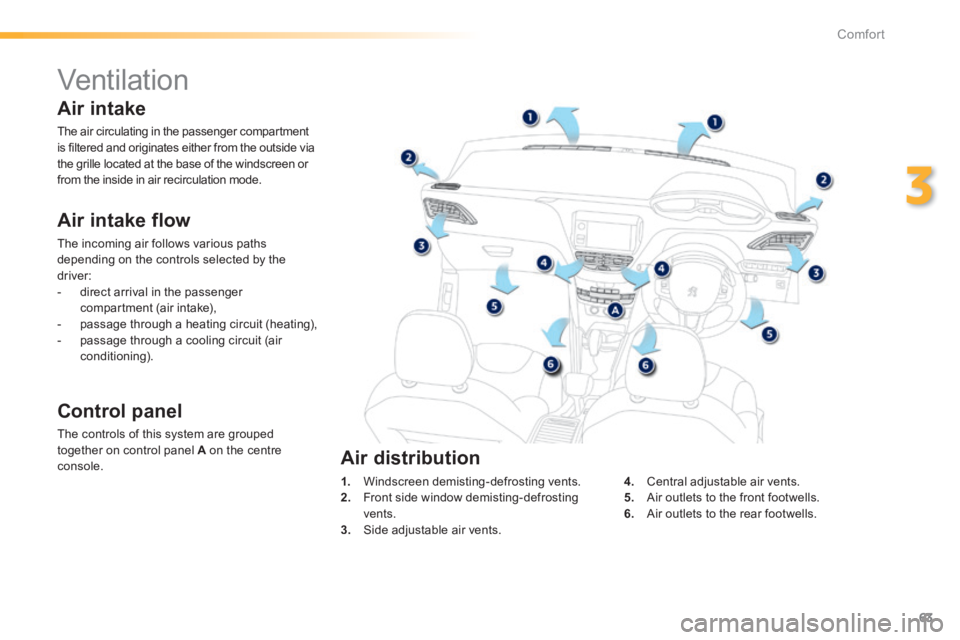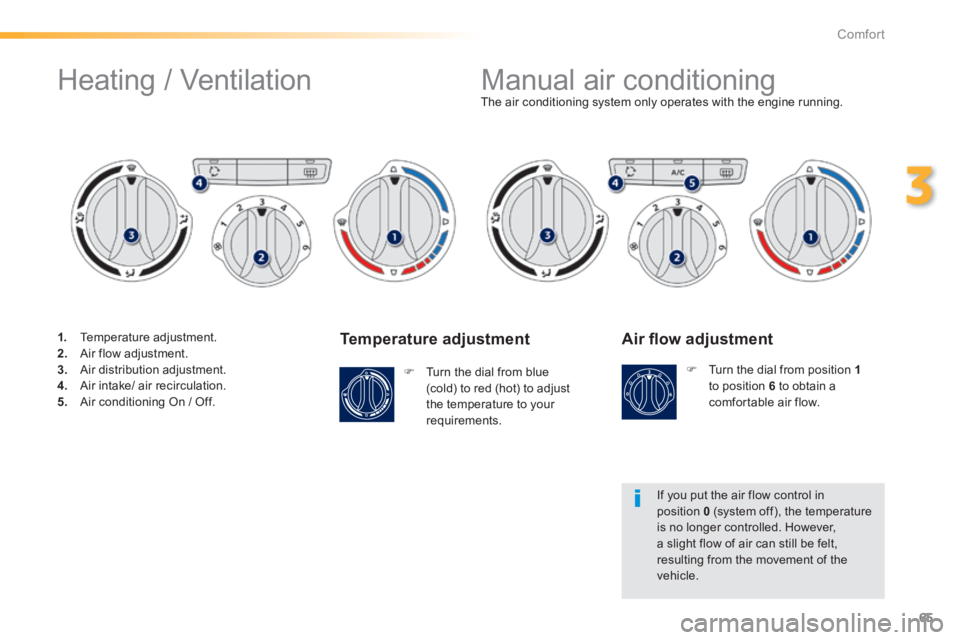2013.5 PEUGEOT 2008 air condition
[x] Cancel search: air conditionPage 4 of 336

.
.
Contents
Instrument panels 21
Indicator and warning lamps 23
Gauges and indicators 33
Trip computer 38
Trip computer with touch screen 40
Setting the date and time 43
Monitoring
Familiarisation
Remote control key
44
Alarm 51
Electric windows 53
Boot 55
Panoramic sunroof 56
Access
Front seats 57
Rear seats 59
Steering wheel adjustment 60
Mirrors 61
Ventilation 63
Heating 65
Manual air conditioning 65
Dual-zone digital air conditioning 67
Front demist - defrost 70
Rear screen demist - defrost 70
Interior fi ttings 71
Boot fi ttings 75
Comfort
Starting - Stopping the engine 79
Manual parking brake 80
Manual gearbox 81
5-speed electronic gearbox 82
6-speed electronic gearbox 85
Automatic gearbox 89
Gear shift indicator 92
Stop & Start 93
Hill start assist 96
Speed limiter 97
Cruise control 99
Parking sensors 102
Park Assist 104
Driving
Lighting controls 108
LED lamps 112
Daytime running lamps 112
Automatic illumination of headlamps 114
Headlamp adjustment 115
Cornering lighting 116
Wiper controls 117
Automatic rain sensitive wipers 119
Courtesy lamps 121
Interior mood lighting 122
Visibility
Eco-driving
Page 9 of 336

.
7
82 122277 215
303
85 67
Familiarisation
Interior
Electronic gearbox
This gearbox provides driving that combines a completely automatic mode and a manual mode. 5-speed
Interior mood lighting
This subdued passenger compartment lighting improves visibility inside the vehicle in low lighting conditions. It comprises several lamps, located below the instrument panel, in the footwells, in the courtesy lamp and on each side of the panoramic sunroof.
Dual-zone digital air conditioning
After setting the desired level of comfort, the system then automatically controls this level according to the ambient conditions.
Audio and communication systems
These systems benefit from the latest technology: MP3 compatible audio systems, USB player, Bluetooth hands-free system, satellite navigation system with colour screen, auxiliary inputs, Hi-Fi audio system, ...
Bluetooth audio system
Audio system
Touch screen
6-speed
Page 10 of 336

8Familiarisation
11. Front side window demisting/defrosting vent. 12 . Instrument panel. 13. Windscreen demisting/defrosting vent. 14 . Sunshine sensor. 15. Glove box / Passenger's airbag deactivation. 16. Passenger's airbag. 17. Multifunction screen / Audio system. 18. Central adjustable air vents. 19. Central locking and hazard warning buttons.
Instruments and controls
1. Cruise control / speed limiter controls. 2. Steering mounted controls for the touch screen. 3. Wiper / screenwash / trip computer stalk. 4. Lighting and direction indicator stalk 5. Bonnet release lever. 6. Steering wheel adjustment control. 7. Driver's airbag. Horn. 8. Headlamp height adjustment. 9. Switch panel. 10. Side adjustable air vents.
20. Heating / air conditioning controls. 21. 12 V accessory socket. USB port / auxiliary socket. Additional USB port. 22. Open storage. Cup holder. 23. Gear lever. 24. Grip control switch. 25. Parking brake. 26. Panoramic sunroof blind opening and closing control. 2 7. Closed storage compartment. 28. Rear 12 V socket.
Page 16 of 336

14
Familiarisation
I require...
Heating or Manual air conditioning
Air distributionAir flowAir recirculation/Intake of exterior airTemperatureManual AC
HOT
COLD
DEMISTING DEFROSTING
Ventilation
Recommended interior settings
Digital air conditioning: use the automatic mode in preference by pressing the "AUTO" button.
Page 21 of 336

19
Eco-driving Eco-driving is a range of everyday practices that allow the motorist to optimise their fuel consumption and CO2 emissions.
Optimise the use of your gearbox
With a manual gearbox, move off gently and change up without waiting. During acceleration change up early.
With an automatic or electronic gearbox, give preference to automatic mode and avoid pressing the accelerator pedal heavily or suddenly.
The gear shift indicator invites you engage the most suitable gear: as soon as the indication is displayed in the instrument panel, follow it straight away. For vehicles fitted with an electronic or automatic gearbox, this indicator appears only in manual mode.
Drive smoothly
Maintain a safe distance between vehicles, use engine braking rather than the brake pedal, and press the accelerator progressively. These practices contribute towards a reduction in fuel consumption and CO2emissions and also helps reduce the background traffic noise.
If your vehicle has cruise control, make use of the system at speeds above 25 mph (40 km/h) when the traffic is flowing well.
Control the use of your electrical
equipment
Before moving off, if the passenger compartment is too warm, ventilate it by opening the windows and air vents before using the air conditioning. Above 30 mph (50 km/h), close the windows and leave the air vents open. Remember to make use of equipment that can help keep the temperature in the passenger compartment down (sunroof and window blinds...). Switch off the air conditioning, unless it has automatic regulation, as soon as the desired temperature is attained. Switch off the demisting and defrosting controls, if not automatic. Switch off the heated seat as soon as possible.
Switch off the headlamps and front foglamps when the level of light does not require their use.
Avoid running the engine before moving off, particularly in winter; your vehicle will warm up much faster while driving.
As a passenger, if you avoid connecting your multimedia devices (film, music, video game...), you will contribute towards limiting the
consumption of electrical energy, and so of fuel. Disconnect your portable devices before leaving the vehicle.
Page 65 of 336

63
3
Comfort
Ventilation
Air intake flow
The incoming air follows various paths depending on the controls selected by the driver: - direct arrival in the passenger compartment (air intake), - passage through a heating circuit (heating), - passage through a cooling circuit (air conditioning).
Control panel
The controls of this system are grouped together on control panel A on the centre console. 1. Windscreen demisting-defrosting vents. 2. Front side window demisting-defrosting vents. 3. Side adjustable air vents.
4. Central adjustable air vents. 5. Air outlets to the front footwells. 6. Air outlets to the rear footwells.
Air distribution
Air intake
The air circulating in the passenger compartment is filtered and originates either from the outside via the grille located at the base of the windscreen or from the inside in air recirculation mode.
Page 66 of 336

64
Comfort
In order for these systems to be fully effective, follow the operation and maintenance guidelines below: To obtain an even air distribution, take care not to obstruct the exterior air intake grilles located at the base of the windscreen, the nozzles, the vents and the air outlets, as well as the air extractor located in the boot. Do not cover the sunshine sensor, located on the dashboard; this is used for regulation of the air conditioning system. Operate the air conditioning system for at least 5 to 10 minutes, once or twice a month to keep it in per fect working order. Ensure that the passenger compartment filter is in good condition and have the filter elements replaced regularly. We recommend the use of a combined passenger compartment filter. Thanks to its special active additive, it contributes to the purification of the air breathed by the occupants and the cleanliness of the passenger compartment (reduction of allergic symptoms, bad odours and greasy deposits). To ensure correct operation of the air conditioning system, you are also advised to have it checked regularly as recommended in the warranty and maintenance record. If the system does not produce cold air, switch it off and contact a PEUGEOT dealer or a qualified workshop. When towing the maximum load on a steep gradient in high temperatures, switching off the air conditioning increases the available engine power and so improves the towing ability.
Recommendations for ventilation and air conditioning
If after an extended stop in sunshine, the interior temperature is very high, first ventilate the passenger compartment for a few moments. Put the air flow control at a setting high enough to quickly change the air in the passenger compartment.
The air conditioning system does not contain chlorine and does not present any danger to the ozone layer.
The condensation created by the air conditioning results in a discharge of water under the vehicle which is per fectly normal.
Stop & Start
The heating and air conditioning systems only work when the engine is running. To maintain a comfortable temperature in the passenger compartment, you can temporarily deactivate the Stop & Start system (see the corresponding section).
Page 67 of 336

65
3
Comfort
Temperature adjustment
Turn the dial from blue (cold) to red (hot) to adjust the temperature to your requirements.
The air conditioning system only operates with the engine running.
Air fl ow adjustment
Turn the dial from position 1to position 6 to obtain a comfortable air flow.
If you put the air flow control in position 0 (system off), the temperature is no longer controlled. However, a slight flow of air can still be felt, resulting from the movement of the vehicle.
Manual air conditioning
Heating / Ventilation
1. Temperature adjustment. 2. Air flow adjustment. 3. Air distribution adjustment. 4. Air intake/ air recirculation. 5. Air conditioning On / Off.